Types of aerators, fuels and electric motors
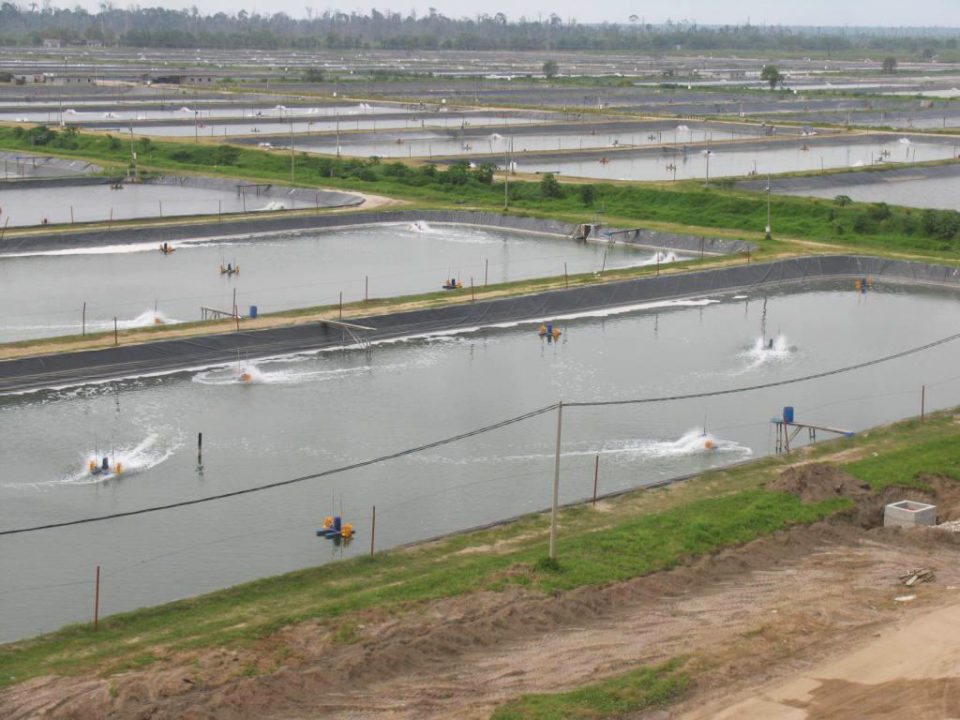
Mechanical aeration is a major component of energy use in shrimp farming. Around 4 million metric tons (MT) of the roughly 5 million MT of farm-reared penaeid shrimp in 2016 were from mechanically aerated ponds. The amount of aeration used in shrimp ponds has not been carefully studied, but shrimp farm managers often use a “rule of thumb” that each 300- to 500-kg increment of shrimp production requires 1 hp of aeration (3.33 to 2.0 hp/MT shrimp). Up to 1.5 MT/ha of shrimp can be produced without aeration, but this quantity usually is not subtracted from the production goal in calculating aeration rate in order to allow a safety factor.
Determination of aeration rate from practical experience is not exact, but the complexity of dissolved oxygen budgets in aquaculture ponds makes it impossible to accurately calculate the aeration rate using equations based on hourly oxygen demand of the water, aerator oxygen transfer efficiency, minimum acceptable dissolved oxygen concentration, and water quality characteristics as done for wastewater treatment basins. Practical experience and monitoring of dissolved oxygen concentration remain the common ways of deciding how much aerator horsepower to install in ponds and for establishing schedules for daily aerator operation.
Small, electric motors use about 1 kWhr (a kilowatt hour is a unit of energy equal to 3.6 megajoules) electricity per horsepower-hour of operation. The amount of energy used per MT of shrimp at an aeration rate of 2.5 hp/MT shrimp with aerators operated in ponds for an average of 16 hours a day during an 80-day grow-out period is quite large. Amounts of electricity (and energy) per hectare will increase steadily as production goal in MT per hectare increases, but the amount of energy applied per MT of shrimp for aeration is 11.5 GJ/MT (2.5 kW/MT ×16 hours/day × 80 days/crop × 0.0036 GJ/kWhr; GJ = gigajoule, a unit of measurement of energy) and constant across all production intensities.
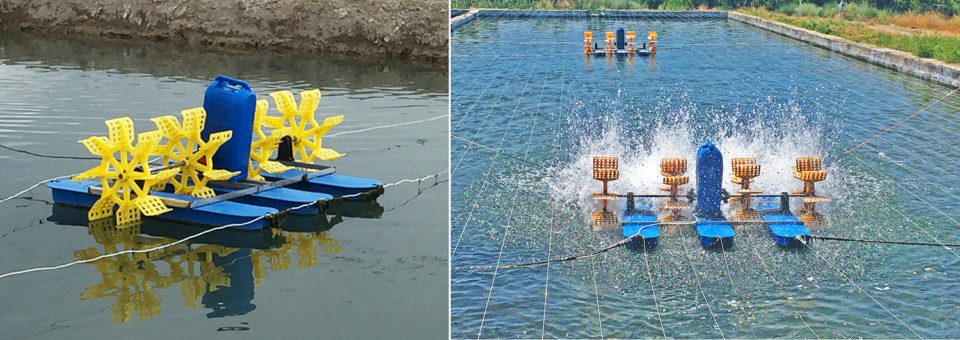
There are several types of aerators; different methods of powering aerators; and energy efficiencies of motors, engines and drive trains differ. The experience-based rule for aerator rate mentioned above was developed years ago in Asia for small 1- or 2-hp floating, electric paddlewheel aerators (image 1 below) that were widely used in shrimp ponds and for 1- to 2-hp propeller-aspirator-pump aerators (image 2 below) that also have received appreciable use in shrimp farming. Over the years, shrimp farmers have learned to fabricate and use less expensive, but also less efficient versions of factory-manufactured aerators. A discussion of the factors influencing the efficiency of energy use in shrimp pond aeration is overdue.
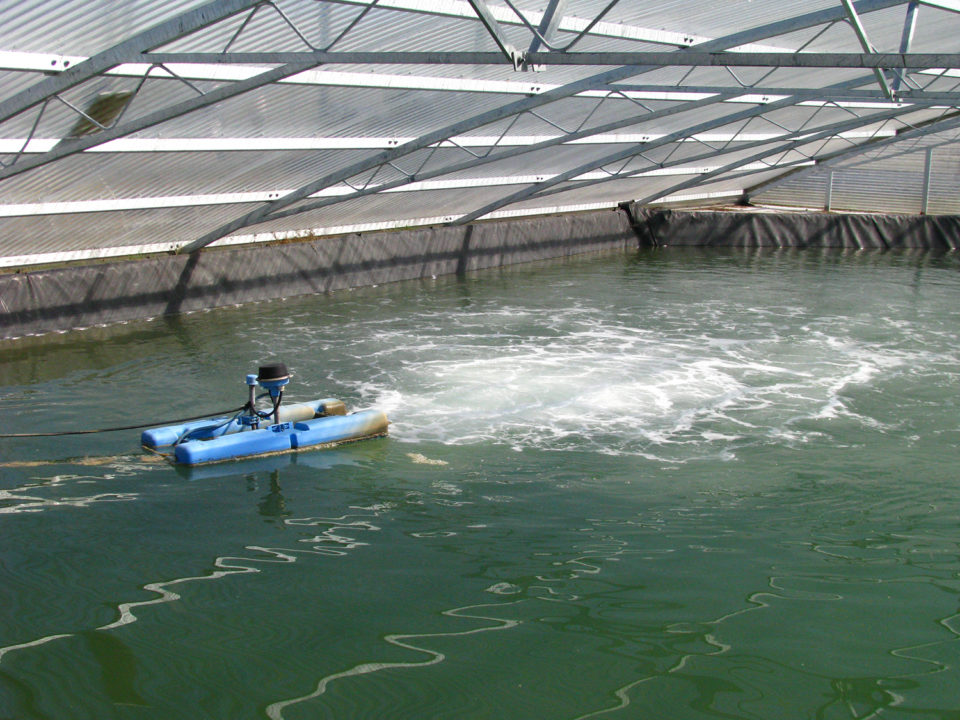
Fuels
Aerators often are powered by electricity supplied by national or regional grids. Electric generators, usually powered by diesel engines located onsite, may also provide electricity for aeration. Fuels differ in energy content (Table 1) and energy also is used to produce these fuels. The total energy use incurred for a fuel is its energy content plus the amount of energy required for its production (embodied energy). Total energy use may be estimated by multiplying the amount of each fuel used by the embodied energy factor for that fuel (Table 1).
Boyd, aeration Pt. 1, Table 1
| Fuel | Energy content (1) | Embodied energy factor |
|---|---|---|
| Ethanol (E100) | 21.27 MJ/L | 1.49 (2) |
| Ethanol (E85) | 22.58 MJ/L | 1.34 (3) |
| LPG (liquid propane gas) | 23.48 MJ/L | 1.12 (4) |
| Gasoline (no ethanol) | 31.80 MJ/L | 1.36 (4) |
| Gasoline (10% ethanol) | 31.25 MJ/L | 1.37 (3) |
| Biodiesel | 33.32 MJ/L | 1.69 (5) |
| Diesel (No. 2) | 35.80 MJ/L | 1.28 (4) |
| Electricity | 3.6 MJ/kWhr | 2.50 |
1: https://afdc.energy.gov/fuels/fuel comparison_chart_pdf.
2: http://large.stanford.edu/courses/2014/ph240/dikeou1/docs/ethanolnetenergy.pdf
3: Calculated.
4: http://www.iea.org/statistics/resources/manuals/
5: https://.adfc.energy.gov/files/pdfs/3229.pdf
The energy contents of a fuel allow determination of the volumes of each fuel necessary to provide the same amount of energy at a specific motor or engine efficiency. For example, 1.68 liters of fuel grade ethanol (E100) would be required to obtain the same amount of energy provided by 1.0 liter of No. 2 diesel fuel (35.80 MJ/L diesel fuel ÷ 21.27 MJ/L ethanol = 1.68; MJ = megajoule, a unit of measurement of energy). Likewise, 9.94 kWhr of electricity represents the same amount of energy as does 1 liter of No. 2 diesel fuel.
Electricity generating plants convert primary energy in coal and other primary fuels with an efficiency of around 40 percent, and there is an additional loss of about 7 percent of the original primary energy in transmission of electricity through the grid – an overall efficiency of about 33 percent. Larger generators are more efficient than smaller generators in converting energy of diesel fuel to electricity (Table 2), but larger units are only 35 to 38 percent efficient, and additional losses will occur in transmission to aerator motors.
Boyd, aeration Pt. 1, Table 2
| Rated output (kW) | Fuel use at 75% load (L/hr) | Energy output at 75% load (% input) | Energy output at 75% load (kW/L) | Energy output at 75% load (MJ/L) |
|---|---|---|---|---|
| 25 | 7.00 | 26.9 | 2.65 | 9.65 |
| 50 | 13.25 | 28.4 | 2.83 | 10.19 |
| 100 | 21.95 | 34.3 | 3.42 | 12.31 |
| 150 | 31.79 | 35.4 | 3.54 | 12.74 |
| 200 | 41.64 | 36.1 | 3.60 | 12.96 |
| 250 | 51.48 | 36.5 | 3.64 | 13.10 |
| 500 | 99.92 | 37.6 | 3.75 | 13.50 |
| 750 | 148.75 | 37.9 | 3.78 | 13.61 |
| 1,000 | 197.20 | 38.1 | 3.80 | 13.68 |
Source: https://www.dieselserviceandsuply.com/Diesel_Fuel_Consumption.aspx.
Energy efficiency from primary fuel is roughly equal for electricity from the national or regional grid and from onsite generators. The cost of primary fuels per kilowatt-hour generated is less for large power plants than for smaller diesel generators, and grid electricity usually is less expensive than electricity generated at shrimp farms.
Electric motors
Synchronous induction, alternating current motors of different types and sizes, are used to power aerators. Smaller electric motors (1 to 3 hp) often are single phase and operate on 110-120 volts (V) or 208-230 V, while larger motors usually are three phase and operate on 208-230 V or even 460 V. Motors usually are rated at full load to require a specific current measured in amperes (Table 3); the amperes required double between 115 V and 230 V motors and between 230 V or 460 V motors.
Boyd, aeration Pt. 1, Table 3
| Motor power rating (hp) | Single phase (115 V) | Single phase (230 V) | Three phase (230 V) | Three phase (460 V) |
|---|---|---|---|---|
| 1 | 16 | 8 | 3.6 | 1.8 |
| 2 | 24 | 12 | 6.8 | 3.4 |
| 3 | 34 | 17 | 9.6 | 4.8 |
| 5 | 56 | 28 | 15.2 | 7.6 |
| 7.5 | 80 | 40 | 22.0 | 11.0 |
| 10 | 100 | 50 | 28.0 | 14.0 |
| 15 | – | – | 42.0 | 21.0 |
| 20 | – | – | 54.0 | 27.0 |
Source: http://mechreps.com/PDF/MRI_Formulas_Conversions.pdf
The efficiency of electric motors is calculated as the energy output by the motor shaft (brake power) divided by the energy input to the motor (wire power) as follows:
kW = Brake hp × 0.746 ÷ Motor efficiency
The typical efficiencies of small electric motors are provided in Table 4. Motors should be operated at around 75 percent full load at which service life and efficiency are greater than at full load. A 10-hp, 230 V, three-phase motor operated at a brake power of 7.5 hp would use around 6.32 kW or 6.32 kW·hr of electricity per hour.
Boyd, aeration Pt. 1, Table 4
| Electric motors | Efficiency (%) | Small (<25 hp) stationary internal combustion engine | Efficiency (%) |
|---|---|---|---|
| 1-4 hp | 78.8 | Ethanol (E100) | 20-25 |
| 5-9 hp | 84.0 | Liquid propane gas (LPG) | 25-30 |
| 10-19 hp | 85.5 | Gasoline | 20-30 |
| 20-49 hp | 88.5 | Diesel | 28-32 |
Source: https://www.engineering toolbox.com/electrical-motor-efficiency-d_655.html
The amperes of electricity used by a motor is roughly in direct proportion to load between 50 and 100 percent full load (Fig. 1). The amperes drawn by an aerator motor can be easily measured with an ammeter during motor operation and the approximate load estimated. There is a substantial no-load current by electric motors, and they waste electricity when substantially under-loaded. The amount of power required to operate paddlewheel aerators increases with greater paddlewheel depth at any rotation speed. Attention to the depth of paddle tip submergence is important, because it can change as the floats for aerators shift during operation. This results in greater or lesser submergence of paddles which can lead to overloading or under-loading of motors.
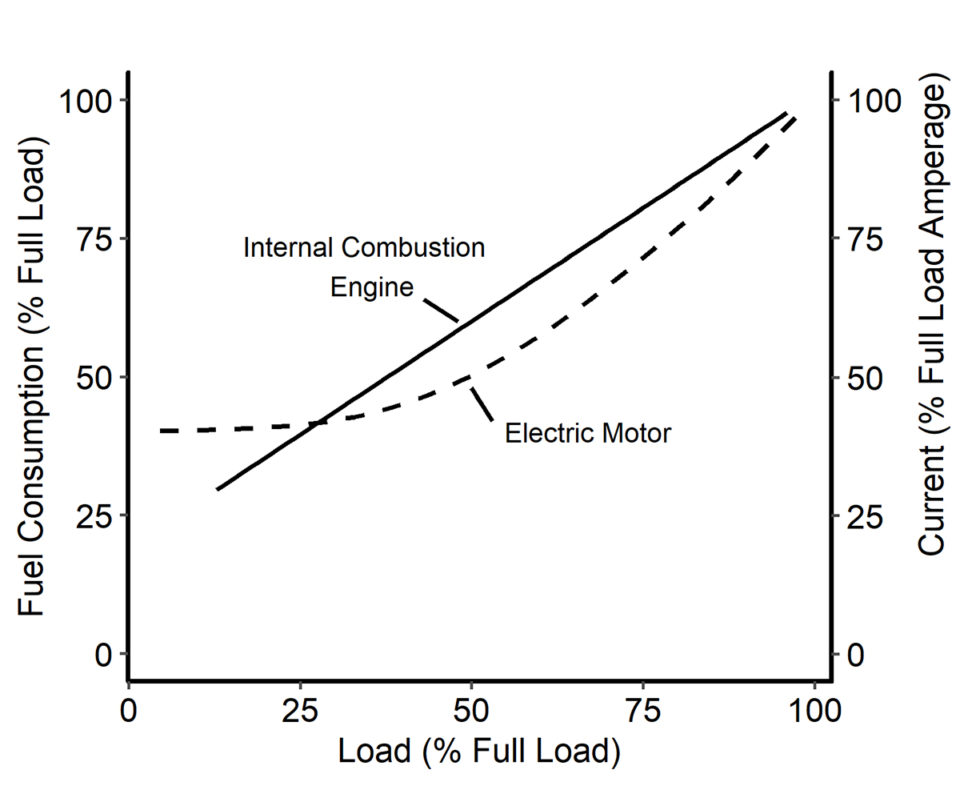
The rotation speed of electric motors varies with the number of magnetic poles in the motor (Table 5). Motor slip under-load reduces output shaft speed by 3 to 5 percent in 1 to 5 hp motors and by around 2 to 3 percent in motors of 7.5 to 20 hp. Motors for paddlewheel aerators usually have a shaft speed of about 1,735 ppm. By contrast, paddlewheels, depending upon their diameter, transfer oxygen most efficiently at 80 to 120 rpm. Motors that turn at such low speeds are more expensive, and speed reducers are placed in the drive train of aerators to allow higher speed motors to be used.
Boyd, aeration Pt. 1, Table 5
| Magnetic poles | Electrical frequency, 50 Hz | Electrical frequency, 60 Hz |
|---|---|---|
| 2 | 3,000 | 3,600 |
| 4 | 1,500 | 1,800 |
| 6 | 1,000 | 1,200 |
| 8 | 750 | 900 |
| 10 | 600 | 720 |
| 12 | 500 | 600 |
| 16 | 375 | 450 |
| 20 | 300 | 360 |
Source: https://www.engineeringtoolbox.com/synchronous-motor-frequency-speed-d_649.html
There also is considerable use of propeller-aspirator-pump aerators in shrimp ponds. Most of these aerators have two-pole motors that rotate at about 3,600 rpm (Table 5). This type of aerator does not transfer as much oxygen per unit of energy if it is supplied with a four-pole motor. Vertical pump aerators for aquaculture typically are supplied with a four-pole motor.
When electric motors are started up, an inrush of electric current is necessary to start the rotor and accelerate the shaft to full speed. For single phase motors of 1 to 10 hp, the inrush current is about three times the full load motor current requirement in amperes. For three-phase motors, the inrush current is about twice the full load current. Large motors usually are started with a motor controller (often called a motor starter) with fuses that withstand the large ampere input at start up.
Now that you've reached the end of the article ...
… please consider supporting GSA’s mission to advance responsible seafood practices through education, advocacy and third-party assurances. The Advocate aims to document the evolution of responsible seafood practices and share the expansive knowledge of our vast network of contributors.
By becoming a Global Seafood Alliance member, you’re ensuring that all of the pre-competitive work we do through member benefits, resources and events can continue. Individual membership costs just $50 a year.
Not a GSA member? Join us.
Author
-

Claude E. Boyd, Ph.D.
School of Fisheries, Aquaculture and Aquatic Sciences
Auburn University
Auburn, Alabama 36849 USA[117,100,101,46,110,114,117,98,117,97,64,49,101,99,100,121,111,98]
Tagged With
Related Posts
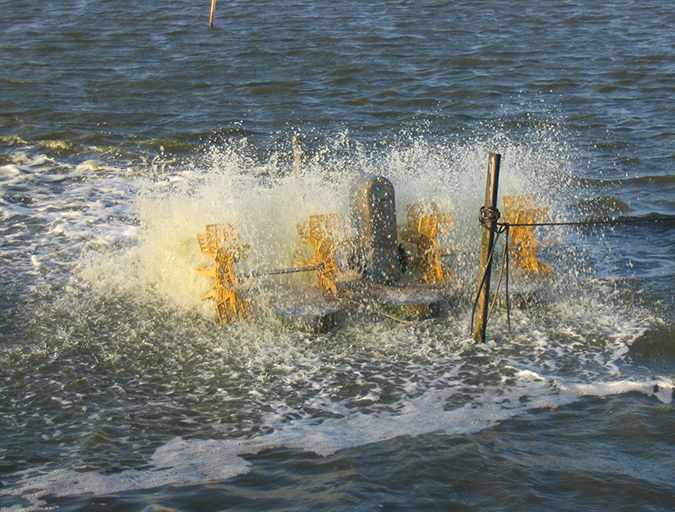
Responsibility
Does Coriolis force impact aerator placement in aquaculture ponds?
The Coriolis effect has no bearing on aerator placement and aquaculture pond management. The most important consideration with mechanical aeration is to provide a sufficient amount to maintain adequate dissolved oxygen concentration.
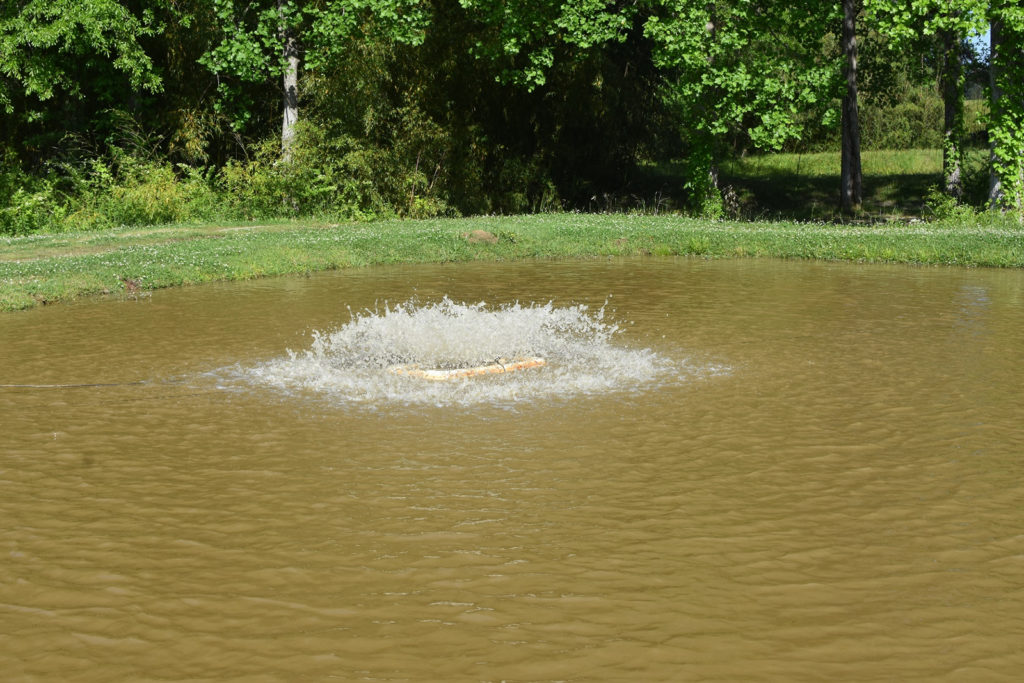
Responsibility
Effects of mechanical aeration on evaporation rate, water temperature
This study compared water temperature and water loss by evaporation in control ponds and in ponds aerated with surface aerators at four different aeration rates. Increased aeration rate increases the evaporation rate, which in turn lowers water temperature.

Innovation & Investment
JALA engineering innovation for Indonesian shrimp farmers
A company in Indonesia hopes the vast network of shrimp farms throughout the country will adopt its IoT device, particularly when they’re on the go.
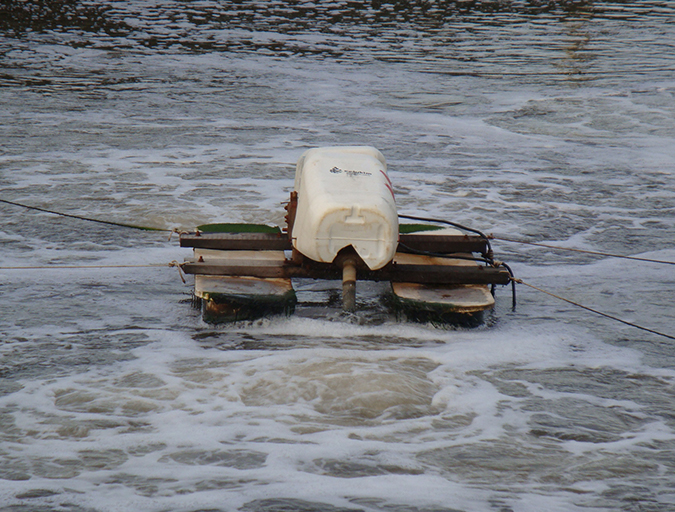
Health & Welfare
Proper water circulation in aquaculture ponds, Part 2
Promoting water circulation during the day time is an effective strategy to enrich pond water with oxygen produced by photosynthesis, and can significantly reduce the costs of night time supplemental aeration. Many types of effective, commercial water circulators are available.


